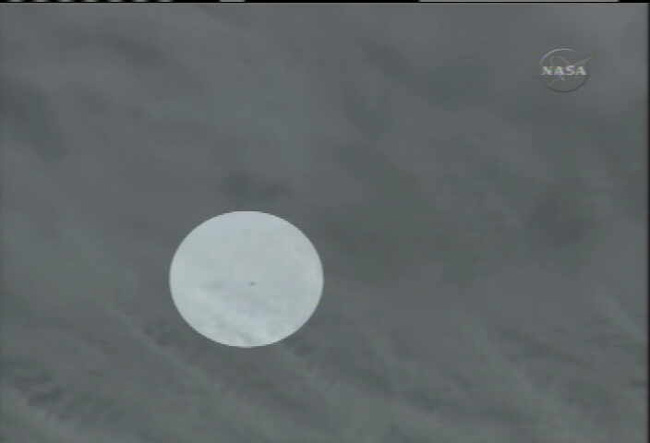Mystery Objects Prompts Third Heat Shield Inspection for Atlantis Crew

CAPE CANAVERAL, - The six astronauts aboard the space shuttleAtlantis will conduct an unprecedented third inspection of their orbiter's heatshield before landing this week to ensure its integrity after an unidentifiedobject appeared to shake free of the spacecraft this morning, NASA's shuttlechief said late Tuesday.
NASA spaceshuttle program manager Wayne Hale said Atlantis' STS-115 astronaut crew willuse their orbiter's 50-foot robotic arm to scan sensitive heat shield areasWednesday and remains on track for a planned landing at the Kennedy Space Center here Thursday at 6:21 a.m. EDT (1021 GMT).
"We stillaiming for Thursday," Hale said. "We have no reason, we think, not to go take alook."
Commandedby veteran NASA spaceflyer Brent Jett, Atlantis' STS-115 crew was slated toland at the Shuttle Landing Facility here at the Kennedy Space Center (KSC) at 5:58 a.m. EDT (0958 GMT) Wednesday after an11-day mission to resume construction of the International Space Station (ISS).
But NASA postponedthe landing attempt earlier today after spotting the mystery object, which appearedto have shaken loose from the orbiter during a series of standard pre-landingflight systems and thruster checks.
"There isconsiderable suspicion that whatever came off the vehicle came off during theflight control systems check-out," Hale said. "We think if this piece cameoff...it will be easier to see. We can scan faster."
Atlantis'STS-115 astronauts have already made two detailed surveys of their orbiter's heatshield using its robotic arm and inspection boom - one just after launch andanother on Monday. Both inspections turned up no signs of any damage to thespacecraft's heat shield.
Get the Space.com Newsletter
Breaking space news, the latest updates on rocket launches, skywatching events and more!
Hale saidthe current plan is to awake Atlantis' six-astronaut crew as planned at 9:45p.m. EDT (0145 Sept. 20 GMT) tonight and begin a five-hour survey of theorbiter's heat shield - including its underbelly - using the shuttle'sCanadian-built robotic arm. Those inspections are expected to begin by about 11:45 p.m. EDT (0345 Sept. 20 GMT), he added.
Only afterthat inspection will shuttle engineers and mission managers decide whether to unstowAtlantis' sensor-laden inspection boom for a closer look at the orbiter's heatshield, a process that would take at least three more hours if completed ontime.
"It'sprobably 50/50 whether we're going to bring the boom out or not," Hale said,adding that a boom inspection must end on time in order for Atlantis' crew tomake their planned Thursday landing attempt for sure. "They'll make a real-timecall."
Mysteryobjects redux
A flightcontroller at NASA's shuttle Mission Control room spotted the debris at about 2:45 a.m. EDT (0645 GMT) Tuesday while using oneof the orbiter's payload bay cameras during routine Earth observations, shuttleofficials said.
Imageanalysts were unable to identify what the mystery object was, and likely willnot be able to, shuttle officials said, though some engineers think it couldstill be a small piece of plastic inadvertently left between tiles alongAtlantis' underbelly.
"We don'tknow that for sure, but it is a likely candidate," Hale said, referring to thebit of orange plastic--known as shim stock--seen dangling from a gap between theprotective heat tiles along Atlantis' belly.
But asecond object photographed by Atlantis' crew is thought to be a simple plasticbag that drifted away from the orbiter.
"We do seethings come off space vehicles from time to time that are really of noconsequence other than we really would not like to leave litter lying around,"Hale said.
Dataindicating eight potential impact sites within two minutes, based on newaccelerometer sensors within the leading edge of one of Atlantis' wings hasbeen put to rest, Hale said, adding that they signals correspond to powerfulmovements of the shuttle's elevons.
The elevonsare used to help steer the orbiter when it flies through Earth's atmosphereduring reentry, and are powered by hydraulics.
Flightcontrollers on Earth conducted a camera survey of Atlantis' payload bay andupper orbiter surfaces while the shuttle's STS-115 crew slept, which will cutdown the amount of time the astronauts spend on robotic operations onWednesday.
"We have,through inspection of the orbiter, cleared many areas of the orbiter," Halesaid of that work, adding that thermal analysis have also found no signs of anyabnormal variations along the orbiter's hull. "In terms of making sure that theshuttle is safe for entry, that's our primary goal and we will know that at theend of the crew's day tomorrow."
- New Gallery: STS-115 Spacewalks
- Gallery: STS-115: Atlantis's Launch Day
- Complete Space Shuttle Mission Coverage
- NASA's STS-115: Shuttle Atlantis to Jump Start ISS Construction
- The Great Space Quiz: Space Shuttle Countdown
Join our Space Forums to keep talking space on the latest missions, night sky and more! And if you have a news tip, correction or comment, let us know at: community@space.com.

Tariq is the Editor-in-Chief of Space.com and joined the team in 2001, first as an intern and staff writer, and later as an editor. He covers human spaceflight, exploration and space science, as well as skywatching and entertainment. He became Space.com's Managing Editor in 2009 and Editor-in-Chief in 2019. Before joining Space.com, Tariq was a staff reporter for The Los Angeles Times covering education and city beats in La Habra, Fullerton and Huntington Beach. In October 2022, Tariq received the Harry Kolcum Award for excellence in space reporting from the National Space Club Florida Committee. He is also an Eagle Scout (yes, he has the Space Exploration merit badge) and went to Space Camp four times as a kid and a fifth time as an adult. He has journalism degrees from the University of Southern California and New York University. You can find Tariq at Space.com and as the co-host to the This Week In Space podcast with space historian Rod Pyle on the TWiT network. To see his latest project, you can follow Tariq on Twitter @tariqjmalik.









